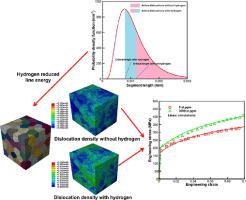当前位置:
X-MOL 学术
›
Mech. Mater.
›
论文详情
Our official English website, www.x-mol.net, welcomes your feedback! (Note: you will need to create a separate account there.)
Dislocation-density based crystal plasticity model with hydrogen-enhanced localized plasticity in polycrystalline face-centered cubic metals
Mechanics of Materials ( IF 3.9 ) Pub Date : 2020-09-01 , DOI: 10.1016/j.mechmat.2020.103472 Shulin Yuan , Yaxin Zhu , Minsheng Huang , Shuang Liang , Zhenhuan Li
Mechanics of Materials ( IF 3.9 ) Pub Date : 2020-09-01 , DOI: 10.1016/j.mechmat.2020.103472 Shulin Yuan , Yaxin Zhu , Minsheng Huang , Shuang Liang , Zhenhuan Li

|
Abstract Hydrogen-enhanced localized plasticity (HELP) has been recognized as an important mechanism for hydrogen embrittlement. Two recognized explinations have been proposed for HELP. The first one is the elastic shielding theory, in which the elastic stress field of solute hydrogen weakens the interactions between dislocations. Another one is the Gibbs theory of absorption isotherm: the lowered dislocation line energy by segregated hydrogen is considered as the main reason. In this work, a dislocation-density based crystal plasticity framework concerning the explicit incorporation of the dislocation line energy is proposed. The explicit consideration of dislocation line energy leads the way to the modelling of HELP mechanism according to the Gibbs theory of absorption isotherm. It is shown that the experimentally observed hydrogen-reduced activation volume and total activation free energy in thermally activated forest intersection in face-centered cubic (FCC) metals can be easily attributed to the reduction of dislocation line energy in the hydrogen environment. Finite element calculations of tensile tests for polycrystalline Pd-H and Ni-H alloys capture several important hydrogen-affected plasticity behaviors: hydrogen-increased flow stress, hydrogen-enhanced dislocation multiplication, hydrogen-promoted heterogeneity of plastic strain and hydrogen-delayed exhaustion of mobile dislocations, which can be all attributed to hydrogen reduced dislocation line energy in the present model. Besides, the influences of hydrogen-reduced vacancy formation free energy and stacking fault energy on thermal annihilation are also considered. However, the simulation results show that they are less important compared with hydrogen-reduced dislocation line energy. The present work is essential for further physically-based modeling of hydrogen distribution in polycrystals and hydrogen-induced damage and failure.
中文翻译:

多晶面心立方金属中氢增强局域塑性的基于位错密度的晶体塑性模型
摘要 氢增强局域塑性(HELP)已被公认为氢脆的重要机制。已经为 HELP 提出了两种公认的解释。第一个是弹性屏蔽理论,其中溶质氢的弹性应力场削弱了位错之间的相互作用。另一个是吸收等温线的吉布斯理论:分离氢降低位错线能量被认为是主要原因。在这项工作中,提出了一种基于位错密度的晶体塑性框架,该框架涉及位错线能量的显式结合。位错线能量的明确考虑导致了根据吉布斯吸收等温线理论对 HELP 机制进行建模的方法。结果表明,实验观察到的面心立方 (FCC) 金属热活化森林交汇处氢减少的活化体积和总活化自由能很容易归因于氢环境中位错线能量的减少。多晶 Pd-H 和 Ni-H 合金拉伸试验的有限元计算捕获了几种重要的氢影响塑性行为:氢增加的流动应力、氢增强的位错倍增、氢促进塑性应变的异质性和氢延迟耗尽移动位错,这都可以归因于本模型中氢减少的位错线能量。除了,还考虑了氢还原空位形成自由能和层错能对热湮灭的影响。然而,模拟结果表明,与氢还原位错线能量相比,它们不太重要。目前的工作对于进一步基于物理建模多晶中的氢分布和氢引起的损坏和失效至关重要。
更新日期:2020-09-01
中文翻译:

多晶面心立方金属中氢增强局域塑性的基于位错密度的晶体塑性模型
摘要 氢增强局域塑性(HELP)已被公认为氢脆的重要机制。已经为 HELP 提出了两种公认的解释。第一个是弹性屏蔽理论,其中溶质氢的弹性应力场削弱了位错之间的相互作用。另一个是吸收等温线的吉布斯理论:分离氢降低位错线能量被认为是主要原因。在这项工作中,提出了一种基于位错密度的晶体塑性框架,该框架涉及位错线能量的显式结合。位错线能量的明确考虑导致了根据吉布斯吸收等温线理论对 HELP 机制进行建模的方法。结果表明,实验观察到的面心立方 (FCC) 金属热活化森林交汇处氢减少的活化体积和总活化自由能很容易归因于氢环境中位错线能量的减少。多晶 Pd-H 和 Ni-H 合金拉伸试验的有限元计算捕获了几种重要的氢影响塑性行为:氢增加的流动应力、氢增强的位错倍增、氢促进塑性应变的异质性和氢延迟耗尽移动位错,这都可以归因于本模型中氢减少的位错线能量。除了,还考虑了氢还原空位形成自由能和层错能对热湮灭的影响。然而,模拟结果表明,与氢还原位错线能量相比,它们不太重要。目前的工作对于进一步基于物理建模多晶中的氢分布和氢引起的损坏和失效至关重要。


























 京公网安备 11010802027423号
京公网安备 11010802027423号